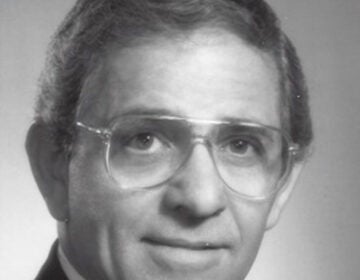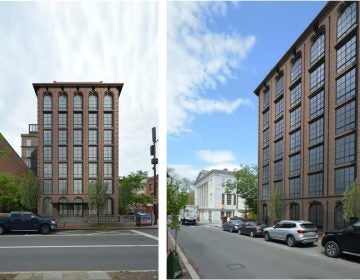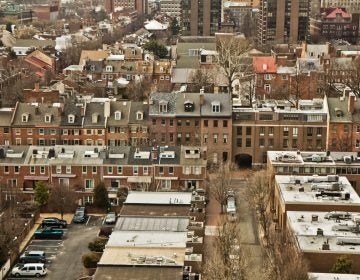Stamper Square (sort of) gets final approval

August 19
By Thomas J. Walsh
For PlanPhilly
A re-worked “plan of development approval” for the controversial Stamper Square development, to be built on the site of the old NewMarket in Headhouse Square, was unanimously approved Tuesday afternoon by the Philadelphia City Planning Commission, after the usual back-and-forth discussion and debate about the ambitious project.
The project was the final subject of an unusual (and unplanned) August Planning Commission meeting. Major developments at 16th and Vine and in Northern Liberties at 2nd and Girard were presented as “information only” sessions for the benefit of the commissioners. Both developers – David Grasso and Bart Blatstein, respectively – said they aim to break ground before the end of 2008.
The Stamper Square approval comes after City Council passed a key re-zoning ordinance for the site in May, which changed the 1.3-acre site from C-2 to C-4, allowing for height and other variances. Developer Marc Stein and his Bridgeman’s Development now need a building permit from the city’s Department of Licenses & Inspections. But because the 15-story combination hotel, condominiums, restaurant and open public space is within a designated historic district, he must also face the Philadelphia Historical Commission.
Just how much authority the Historical Commission has over the project’s ultimate green light seems to be an open question. Elise Vider, deputy director of the Preservation Alliance of Greater Philadelphia, and Paul Boni, an attorney who lives close to the site and is against it, said after Tuesday’s meeting that the commission can hold up construction if it deems the effort unworthy of its surroundings. Both testified in front of the Planning commissioners, urging them to delay approval on the grounds that a problem with the Historical Commission would likely bring the project back to them.
But Gary Jastrzab, the Planning Commission’s acting executive director, said it was his understanding that the Historical Commission could only give a recommendation. “The [Planning] staff’s position is that this is what the neighborhood needs,” Jastrzab told PlanPhilly.
Martin Gregorski, the staff planner who made the initial presentation of approval to the commissioners, said that actually, the Historical Commission has plenty of say in the matter, and that developers would be hard-pressed to get L&I permits if another city agency says there are problems.
One thing is certain, according to one commissioner: Basic L&I paperwork lists the Historical Commission as one of the bodies that need to eyeball any given project if it is, well, historic.
Jonathan Farnham, the commission’s executive director, could not be reached for comment early Tuesday evening.
Vider and Boni said that Bridgeman’s had already been before the Historical Commission, earlier this year, and on Monday Stein confirmed that. Both parties said there was a split opinion from the commission’s architecture committee. But Stein did an end run by simply pulling his application to the Historical Commission, Vider and Boni contend, until zoning and planning approvals were in hand – that is, as of Tuesday afternoon. Stein said Monday that plans had needed alteration after settling differences with neighborhood groups, so it was necessary to pull back for a time.
In any case, the “plan of development approval,” as described by Gregorski, means that if major changes to the development are necessary, they must come through the Planning Commission first. That includes site plans, “massing” and height changes, floor area ratios and three deed restrictions for use and operation, including a sunset clause for the commencement of construction – mid-April 2009.
The split
People who live near Headhouse Square are still divided on the issue, but Bridgeman’s has seemingly made peace with the Society Hill Civic Association. An SHCA envoy was sent to convey the group’s understated blessing.
Others complained that some neighbors were being compensated for going along with the project, while those who objected are now being penalized – something that Stein and his legal counsel readily admit (though not to the concept of penalization per se). Some residents were entitled to a parking spot as part of a covenant with the former NewMarket space, the two said. If the neighbors signed on, backing the project, that spot would be delivered.
“Some neighbors had existing legal rights to parking under NewMarket,” said Bill Martin, Stein’s lawyer. “To the extent individuals were going to actively oppose approvals, we were not going to allow them” those rights.
Commissioner Camille Cates Barnett, the city’s Managing Director, wanted to make sure she had that clear, because it was also posited that neighbors who had no such pre-existing right to a valuable parking spot could also get one, in exchange for their loyalty.
Correct, Martin said (condensing his response). So, it’s not really about the past NewMarket garage agreement at all, is it? Barnett asked. That’s right, Martin said, in effect.
Eyebrows near the ceiling, Barnett looked incredulous, but did not press. Alan Greenberger, the Planning Commission’s vice chairman and its executive director-elect, did – a bit. “I have concerns about that,” he said. “I think you should rise above it.” After consultation with a lawyer for the commission, though, he dropped the subject to concentrate on planning matters.
As for the approval of the Historical Commission, Greenberger said Stein was “on a separate path needed by the developer, but that’s not for us now.” The re-zoning has been signed into law, he said, and the mayor signed it.
The neighbor with the big guns
An interesting side story developed when Greenberger questioned one of the three deed restrictions, which bars outdoor dining on the site, something that was in the original plan.
Isn’t outdoor seating at high-end restaurants what the city wants as part of a vibrant street life? Greenberger asked. What’s up with that?
Martin explained that it was the result of losing a battle to win the war – that at least two neighbors with clout threatened to sue over the matter, and one was close to a senior partner at a major Center City law firm. Martin didn’t name names. But he did say, in no uncertain terms, that he believed that this particular neighbor may well have access to “unlimited” legal heft.
In polite terms, it was a handshake deal, in the form of a deed restriction, and in lieu of, presumably, unmitigated litigation hell from said unnamed neighbor.
This time, Greenberger was having none of it. He said if Bridgeman’s wanted to come to an agreement with an aggrieved party, it should do so privately, not under the city’s jurisdiction. Martin was fine with that – after all, the aggrieved party could end up moving, he said. If there was no deed restriction on outdoor seating, there would be no need to reappear before the Zoning Board of Adjustment. Or, he added, the angry, threatening neighbor “might die.”
Something in the way that thought was delivered, combined with Greenberger’s slight pause before continuing, gave the crowded room the opportunity for a much-needed laugh.
Contact the reporter at thomaswalsh1@gmail.com.
WHYY is your source for fact-based, in-depth journalism and information. As a nonprofit organization, we rely on financial support from readers like you. Please give today.






